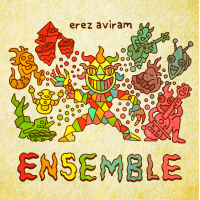Home » Jazz Musicians » Gunther Schuller
Gunther Schuller

The composer Gunther Schuller is, famously, a man of many musical pursuits. He began his professional life as a horn player in both the jazz and classical worlds, working as readily with Miles Davis and Gil Evans as with Toscanini; he was principal horn of the Cincinnati Symphony from age sixteen and later of the Metropolitan Opera Orchestra until 1959.
In the 1950s he began a conducting career focusing largely on contemporary music, and thereafter conducted most of the major orchestras of the world in a wide range of works, including his own. He was central in precipitating a new stylistic marriage between progressive factions of jazz and classical, coining the term "Third Stream" and collaborating in the development of the style with John Lewis, the Modem Jazz Quartet, and others.
An educator of extraordinary influence, he has been on the faculties of the Manhattan School of Music and Yale University; he was, for many years, head of contemporary music activities (succeeding Aaron Copland) as well as a director of the Tanglewood Music Center, and served as President of the New England Conservatory. He has published several books and recently embarked on the writing of his memoirs.
In the late 1970s he started the GunMar and Margun music publishing companies and later the GM Recordings label. (The GunMar/ Margun catalogs are now part of G. Schirmer/Music Sales/AMP.) Composition has had a continual central presence in Schuller's musical life: he has written more than 180 works dating back to the beginning of his career when, at age nineteen, he was soloist in his own Horn Concerto with the Cincinnati Symphony Orchestra under Eugene Goosens. His works range from solo works to concertos, symphonies, and opera, and many fall outside of any genre (for which reason there can be no such thing as a brief and comprehensive overview of his output).
Gunther Schuller's orchestral works include some of the classics of the modern repertoire written for the major orchestras of the world. Prominent among these are several masterful examples in the "Concerto for Orchestra" genre, though not all of them take that title. An early example is Spectra (1958), commissioned by the New York Philharmonic for the orchestra's departing music director Dimitri Mitropoulos. Schuller reconfigured musical space by organizing the ensemble onstage into smaller chamber groups within the larger orchestra, and also concentrated on instrumental timbre as a defining aspect of the piece's form and expression; both of these aspects were cutting-edge for the time, foreshadowing concerns of later composers. Spectra remains a compelling orchestral essay alongside such other works as the Concerto for Orchestra No. 1: Gala Music (1966), written for the Chicago Symphony Orchestra; Concerto for Orchestra No. 2 (1976) for the National Symphony Orchestra; and Farbenspiel (Concerto for Orchestra No. 3) (1985), written for the Berlin Philharmonic. The title of the latter, translatable as "play of colors," echoes the visual metaphor of Spectra.
Read moreTags
Gunther Schuller: Heralding Charles Mingus

by Judith Insell
Gunther Schuller, one of jazz's foremost scholars, arrangers, composers and conductors, takes the stage with the Mingus Orchestra at New York's Merkin Hall this month. All About Jazz spoke with the octogenarian musical icon about his longstanding association with [bassist/composer] Charles Mingus and his travels through the jazz and classical music genres.
All About Jazz: Could you tell me about the upcoming Merkin Hall concert?
Gunther Schuller: I am simply what we normally call a “guest ...
Continue ReadingGunther Schuller Turns 75!

by Scott Menhinick
All About Jazz: I was curious about what kind of influence your father being a professional musician had on your choice to follow a musical path.Gunther Schuller: Enormous, except not formal. I heard great music in my mother's womb and my father was in the New York Philharmonic so I was taken to concerts and of course I heard him practice. Also, New York City was full of excellent radio programs, classical music particularly in those days-that's all ...
Continue ReadingNovember 15-22, 2025: Jumpin’ In The Future: The Legacy Of Gunther Schuller

Source:
Braithwaite & Katz Communications
New England Conservatory (NEC) presents the week-long festival Jumpin’ in the Future: The Legacy of Gunther Schuller from November 15 to November 22, 2025. The festival features performances and discussions at whose core is the fearless innovation and revolutionary spirit Schuller brought to NEC and which continues to this day. A MacArthur Fellow and Pulitzer Prize winner, Schuller began a decade as president of NEC in 1967 establishing the first fully accredited Jazz Studies Department at an American conservatory and ...
read more
From Ragtime To Early Jazz – Celebrating New England Conservatory’s Ragtime Legacy On Tuesday, November 21 At Jordan Hall

Source:
Braithwaite & Katz Communications
The Gunther Schuller Society and New England Conservatory’s Contemporary Musical Arts and Jazz Studies departments will honor the birthday of the most transformative figure in NEC’s history with From Ragtime to Early Jazz, the Gunther Schuller Legacy Concert on Tuesday, November 21. Directed by CMA co-chair Hankus Netsky, From Ragtime to Early Jazz celebrates the 50th anniversary of Schuller’s 1973 Grammy Award-winning The Red Back Book recording which re-introduced chamber orchestra arrangements of Scott Joplin’s music originally published around 1912. ...
read more
Jazz Musician of the Day: Gunther Schuller

Source:
Michael Ricci
All About Jazz is celebrating Gunther Schuller's birthday today!
The composer Gunther Schuller is, famously, a man of many musical pursuits. He began his professional life as a horn player in both the jazz and classical worlds, working as readily with Miles Davis and Gil Evans as with Toscanini; he was principal horn of the Cincinnati Symphony from age sixteen and later of the Metropolitan Opera Orchestra until 1959. In the 1950s he began a conducting career focusing largely on ...
read more
New England Conservatory’s Contemporary Musical Arts Program Presents November Events Celebrating 50th Anniversary

Source:
Ann Braithwaite
New England Conservatory’s Contemporary Musical Arts (CMA) program marks five decades of crossing boundaries, pushing limits, and training creative contemporary musicians and artists with a CMA Festival from Saturday, November 12–Thursday, November 17 and a concert honoring Gunther Schuller’s legacy on Tuesday, November 22. The festival, part of a year-long celebration featuring faculty, students and alumni in cutting-edge musical events, showcases bluegrass, African, Irish, classical, Americana, Middle Eastern music, klezmer, folk, jazz, electronic, rock, film noir and beyond, just some ...
read more
Jazz Musician of the Day: Gunther Schuller

Source:
Michael Ricci
All About Jazz is celebrating Gunther Schuller's birthday today!
The composer Gunther Schuller is, famously, a man of many musical pursuits. He began his professional life as a horn player in both the jazz and classical worlds, working as readily with Miles Davis and Gil Evans as with Toscanini; he was principal horn of the Cincinnati Symphony from age sixteen and later of the Metropolitan Opera Orchestra until 1959. In the 1950s he began a conducting career focusing largely on ...
read more
Jazz Musician of the Day: Gunther Schuller

Source:
Michael Ricci
All About Jazz is celebrating Gunther Schuller's birthday today!
The composer Gunther Schuller is, famously, a man of many musical pursuits. He began his professional life as a horn player in both the jazz and classical worlds, working as readily with Miles Davis and Gil Evans as with Toscanini; he was principal horn of the Cincinnati Symphony from age sixteen and later of the Metropolitan Opera Orchestra until 1959. In the 1950s he began a conducting career focusing largely on ...
read more
Jazz Musician of the Day: Gunther Schuller

Source:
Michael Ricci
All About Jazz is celebrating Gunther Schuller's birthday today!
The composer Gunther Schuller is, famously, a man of many musical pursuits. He began his professional life as a horn player in both the jazz and classical worlds, working as readily with Miles Davis and Gil Evans as with Toscanini; he was principal horn of the Cincinnati Symphony from age sixteen and later of the Metropolitan Opera Orchestra until 1959. In the 1950s he began a conducting career focusing largely on ...
read more
Jazz Musician of the Day: Gunther Schuller

Source:
Michael Ricci
All About Jazz is celebrating Gunther Schuller's birthday today!
The composer Gunther Schuller is, famously, a man of many musical pursuits. He began his professional life as a horn player in both the jazz and classical worlds, working as readily with Miles Davis and Gil Evans as with Toscanini; he was principal horn of the Cincinnati Symphony from age sixteen and later of the Metropolitan Opera Orchestra until 1959. In the 1950s he began a conducting career focusing largely on ...
read more
Jazz Musician of the Day: Gunther Schuller

Source:
Michael Ricci
All About Jazz is celebrating Gunther Schuller's birthday today!
The composer Gunther Schuller is, famously, a man of many musical pursuits. He began his professional life as a horn player in both the jazz and classical worlds, working as readily with Miles Davis and Gil Evans as with Toscanini; he was principal horn of the Cincinnati Symphony from age sixteen and later of the Metropolitan Opera Orchestra until 1959. In the 1950s he began a conducting career focusing largely on ...
read more
Jazz Musician of the Day: Gunther Schuller

Source:
Michael Ricci
All About Jazz is celebrating Gunther Schuller's birthday today!
The composer Gunther Schuller is, famously, a man of many musical pursuits. He began his professional life as a horn player in both the jazz and classical worlds, working as readily with Miles Davis and Gil Evans as with Toscanini; he was principal horn of the Cincinnati Symphony from age sixteen and later of the Metropolitan Opera Orchestra until 1959. In the 1950s he began a conducting career focusing largely on ...
read more





























